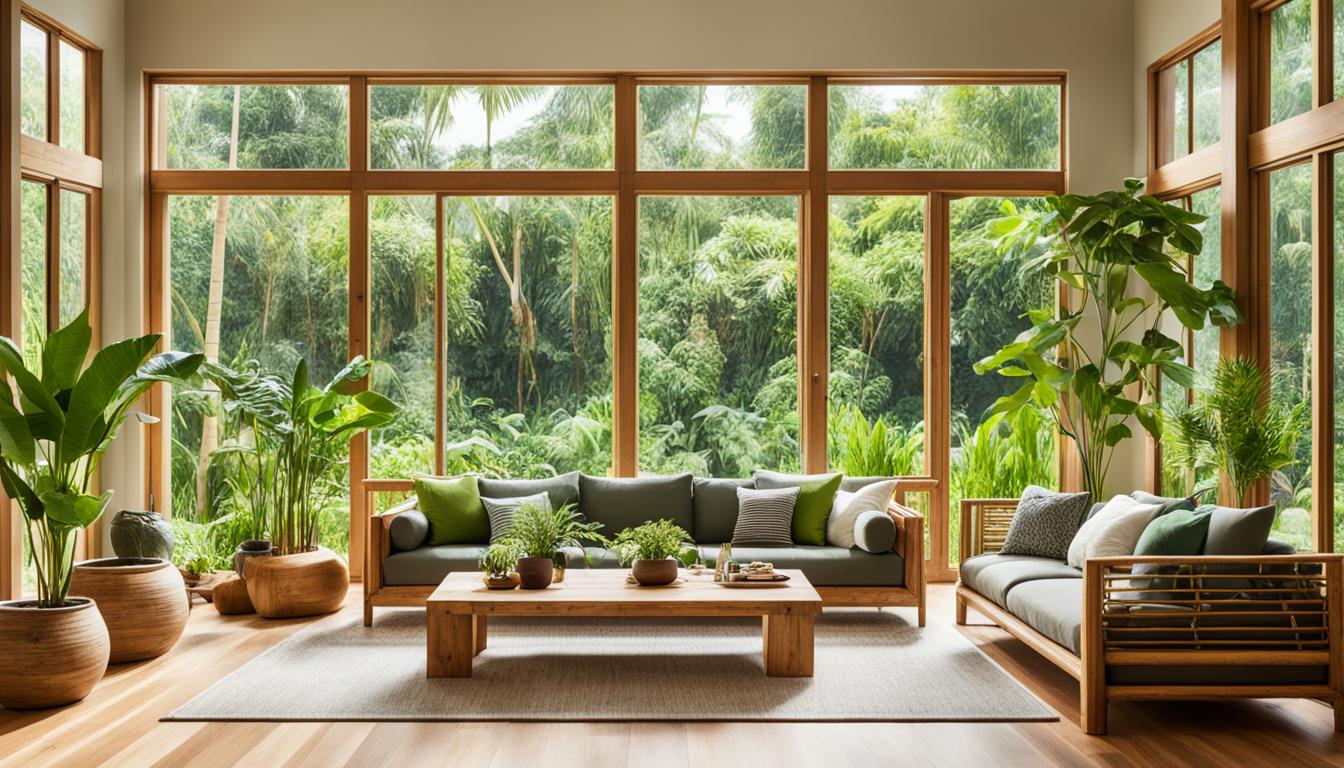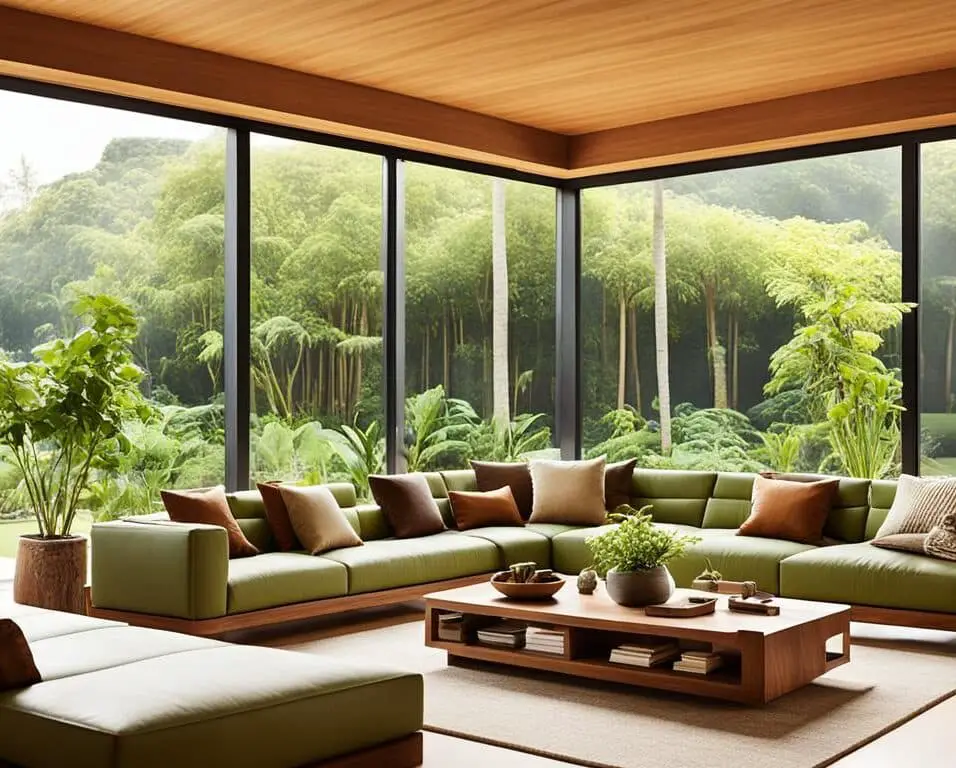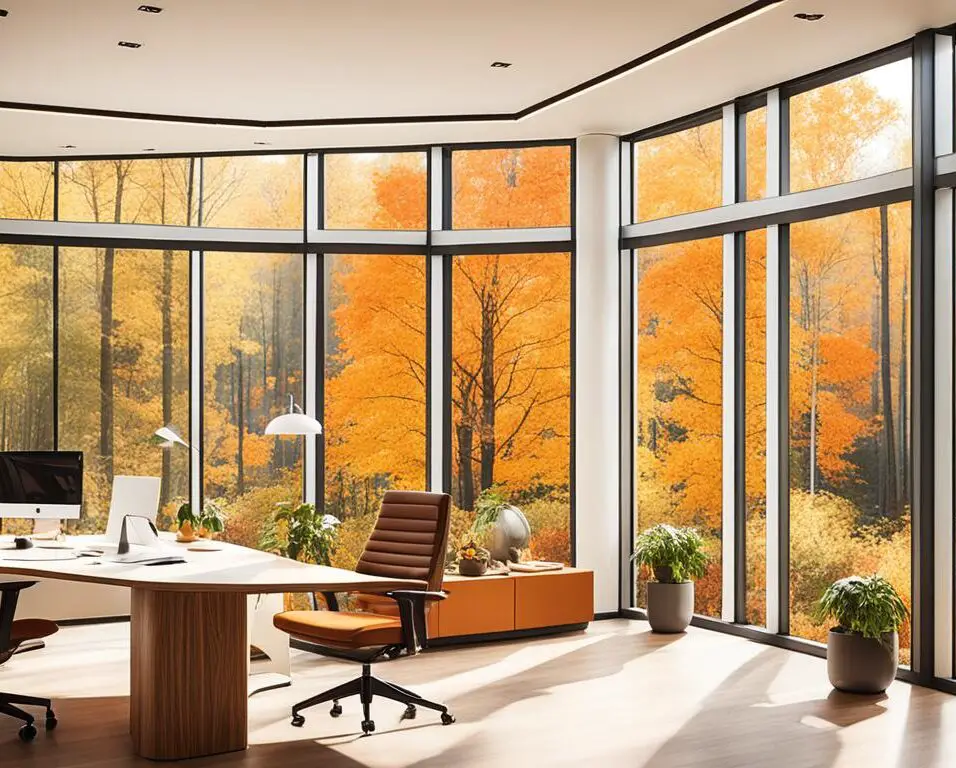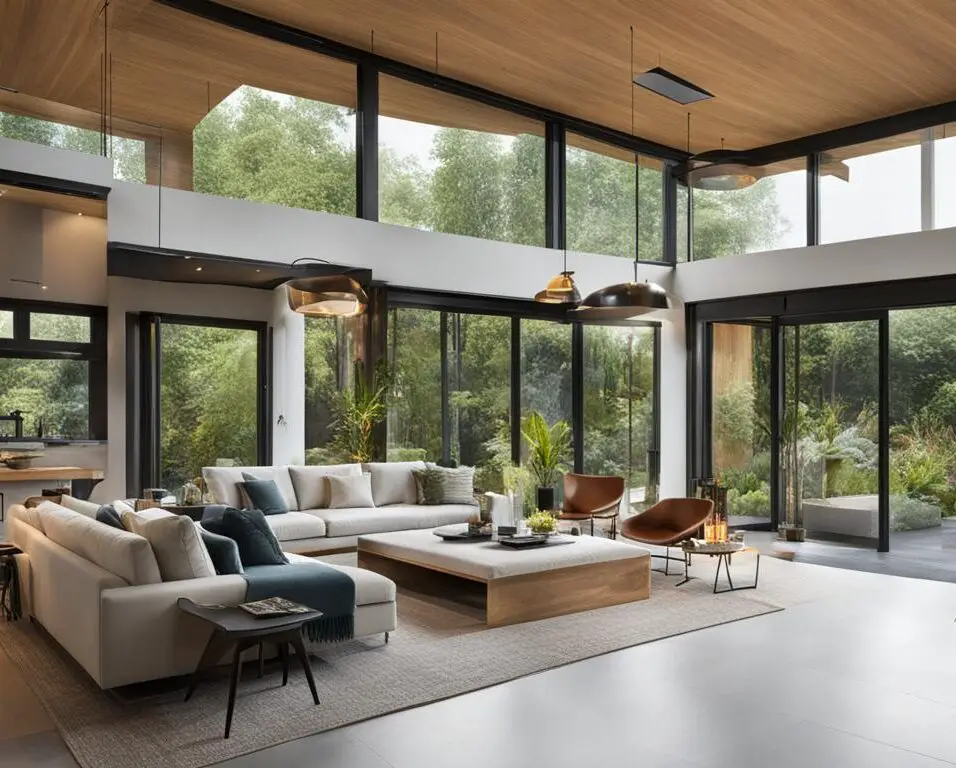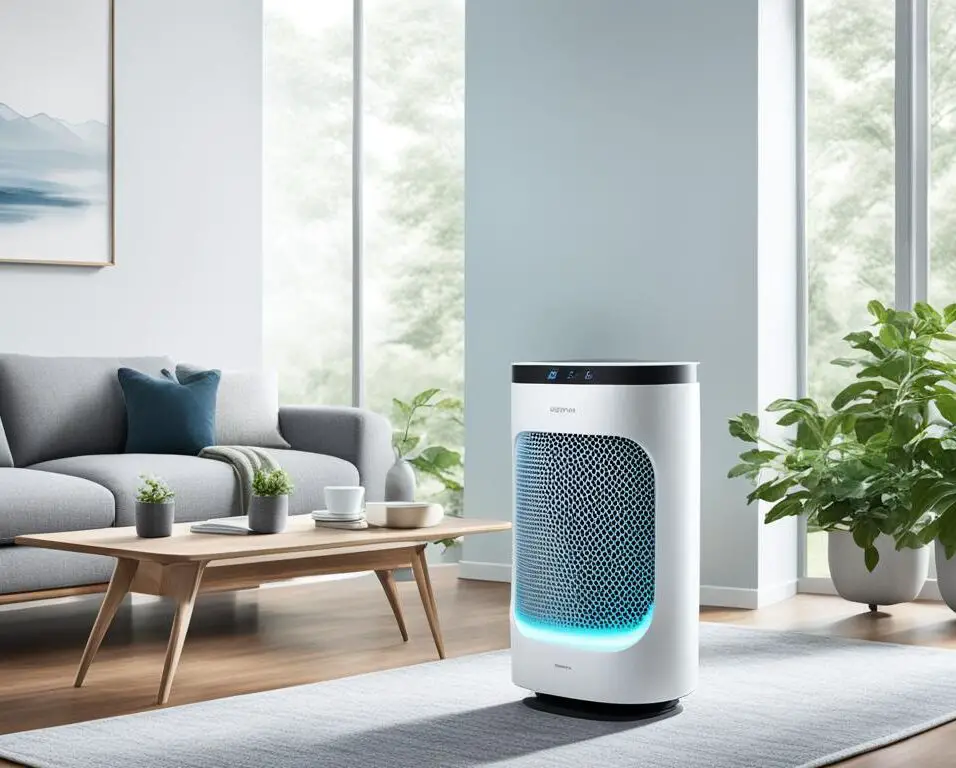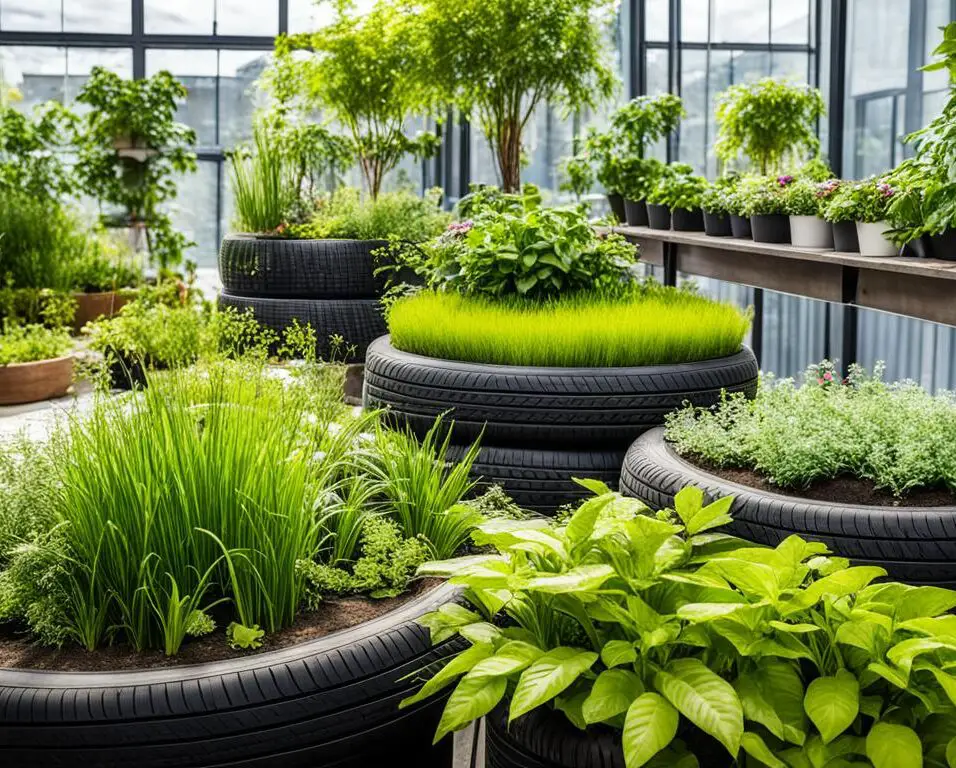Renovating with Nature: Biophilic Design in Home Remodeling
I am thrilled to introduce the transformative concept of biophilic design in home remodeling projects. As a professional in the field, I have witnessed the rising popularity of this approach that recognizes the deep connection between humans and nature and aims to bring the beauty and tranquility of the natural world into our indoor spaces.
Biophilic design has become a prominent trend in interior design, particularly in renovation projects. Homeowners are increasingly seeking to create harmonious living spaces that incorporate elements of nature, and biophilic design provides the perfect solution.
In this article, I will explore the rise of biophilic design in the field of interior design, its tangible benefits in home remodeling, key elements to consider in renovation projects, and its application in different rooms of the home. Furthermore, I will explain how biophilic design aligns with sustainability efforts and discuss its exciting future in the world of home remodeling trends.
Key Takeaways:
- Biophilic design is a transformative approach in home remodeling that brings elements of nature into indoor spaces.
- It recognizes the innate connection between humans and nature and aims to create harmonious living spaces.
- Biophilic design offers numerous benefits, including stress reduction, improved cognitive function, and enhanced well-being.
- Key elements of biophilic design include natural materials, indoor plants, maximizing natural light, and creating spaces for relaxation and reflection.
- Biophilic design principles can be applied to every room in the home, creating calming and inviting atmospheres.
The Rise of Biophilic Design in Interior Design
Biophilic design has firmly established its presence in the field of interior design. It acknowledges the positive impact that nature has on human well-being and seeks to create spaces that promote physical and mental health by incorporating natural elements. This trend has gained momentum in recent years and is now a prominent feature in many renovation projects. Homeowners are increasingly embracing biophilic design principles to create a sense of tranquility and connection to nature within their living spaces.
In the fast-paced modern world, where people are spending more and more time indoors, biophilic design offers a refreshing approach to interior design. By integrating natural materials, colors, and patterns, as well as elements such as plants, water features, and natural light, biophilic design brings the outdoors inside, creating a harmonious and rejuvenating environment.
“Biophilic design goes beyond aesthetics. It taps into our innate connection with nature and leverages the power of natural elements to improve our well-being.”
Biophilic design not only enhances the visual appeal of a space but also has numerous benefits for human health and well-being. Studies have shown that exposure to nature, even in artificial forms, can reduce stress, improve cognitive function, and boost mood and creativity. By incorporating biophilic design principles into their homes, individuals can create spaces that promote relaxation, productivity, and overall well-being.
Furthermore, biophilic design aligns with the growing demand for sustainable and eco-friendly practices in interior design. By using natural and environmentally friendly materials, homeowners can create spaces that are not only beautiful but also sustainable.
Statistics on the Growth of Biophilic Design
| Year | Percentage of Interior Design Projects Incorporating Biophilic Design |
|---|---|
| 2015 | 35% |
| 2018 | 45% |
| 2021 | 60% |
The table above illustrates the increasing adoption of biophilic design in interior design projects over the years. This upward trend showcases the growing recognition of the importance of creating spaces that reconnect humans with nature.
Overall, the rise of biophilic design in interior design reflects the shift towards creating spaces that holistically promote human well-being and environmental sustainability. It is a trend that is here to stay, as more homeowners recognize the transformative power of bringing nature indoors.
Key Features of Biophilic Design
- Use of natural materials such as wood, stone, and bamboo.
- Integration of indoor plants and green walls for improved air quality.
- Maximizing natural light through the use of large windows and skylights.
- Incorporation of water features such as fountains or aquariums.
- Utilization of natural colors and patterns inspired by natural elements.
- Creation of views of nature through strategic placement of windows and mirrors.
- Designing spaces for relaxation and contemplation.
By incorporating these key features, homeowners can transform their living spaces into oases of tranquility, promoting wellness and connection to the natural world.
The Benefits of Biophilic Design in Home Remodeling
Incorporating biophilic design principles into home remodeling projects offers numerous benefits. Studies have shown that exposure to natural elements such as sunlight, greenery, and natural textures can reduce stress, improve cognitive function, and enhance overall well-being. Biophilic design can also improve air quality, promote better sleep, and increase productivity. By bringing nature indoors, homeowners can create spaces that are not only aesthetically pleasing but also promote their health and happiness.
Research has consistently demonstrated the positive impact of biophilic design on human well-being. Here are some key benefits:
- Stress reduction: The presence of natural elements in indoor spaces has been found to have a calming effect on individuals, reducing stress levels and promoting relaxation.
- Enhanced cognitive function: Exposure to nature has been linked to improved cognitive function, including increased focus, creativity, and problem-solving abilities.
- Better air quality: Incorporating plants and natural ventilation systems in home remodeling projects can improve indoor air quality by filtering pollutants and increasing oxygen levels.
- Improved sleep: Biophilic design can create a peaceful and soothing environment that supports restful sleep, leading to improved overall health and well-being.
- Increased productivity: Studies have shown that access to nature in the workplace or home environment can boost productivity, creativity, and job satisfaction.
“Biophilic design has the potential to revolutionize the way we approach home remodeling. By embracing the beauty and serenity of nature, we can create spaces that nourish our mind, body, and soul.”
By integrating elements such as natural light, indoor plants, organic materials, and views of nature, homeowners can transform their living spaces into sanctuaries that provide a multitude of benefits. Biophilic design not only enhances the aesthetic appeal of a home but also contributes to the overall well-being of its occupants.
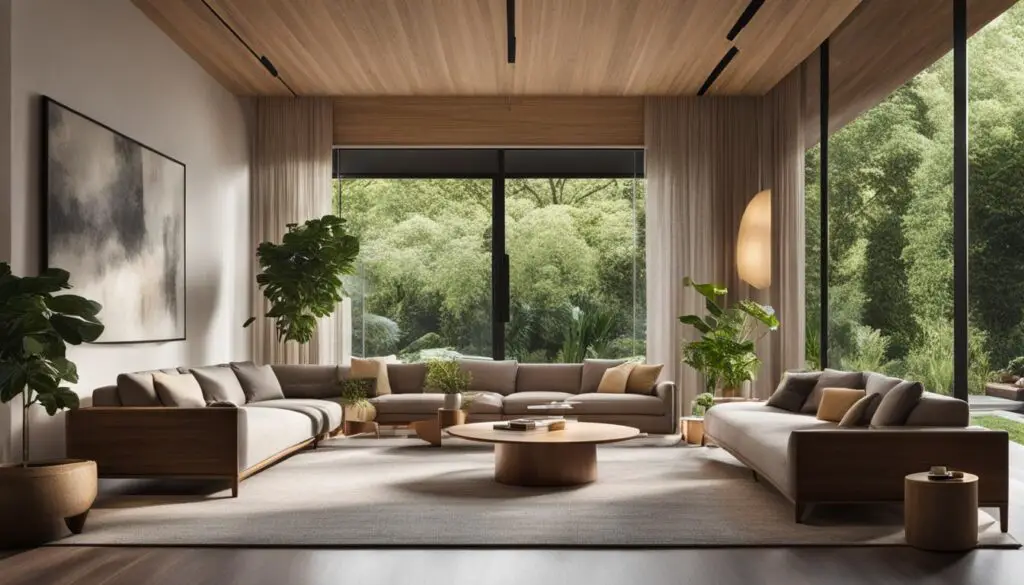
Note: The image above showcases the tranquility and natural beauty that can be achieved through biophilic design in home remodeling projects.
Biophilic Design Elements to Consider in Renovation Projects
When embarking on a renovation project, incorporating biophilic design elements can transform your space into a sanctuary that connects with nature. By integrating these elements, you can create a harmonious and tranquil environment that enhances your well-being. Here are some key elements to consider:
- Natural Materials: Utilize materials such as wood, stone, and bamboo to bring the warmth and beauty of nature into your space.
- Indoor Plants and Green Walls: Integrate living plants and vertical gardens to purify the air and create a sense of natural serenity.
- Maximizing Natural Light: Incorporate large windows and skylights to invite ample natural light, creating a brighter and more uplifting atmosphere.
- Water Features: Consider incorporating water features like fountains or aquariums to introduce the calming effect of flowing water.
- Natural Colors and Patterns: Use earthy tones and organic patterns to evoke a sense of nature’s presence within your space.
- Views of Nature: Design your space to offer views of the outdoors, whether it’s a garden, park, or landscape, to foster a deeper connection with the natural world.
- Spaces for Relaxation and Reflection: Create cozy corners or meditation areas that promote relaxation and contemplation, allowing you to unwind amidst nature-inspired surroundings.
By incorporating these biophilic design elements into your renovation projects, you can create a space that not only looks appealing but also fosters a sense of well-being and balance. Let nature be your partner in creating a home that rejuvenates and reconnects.
Biophilic Design in Different Rooms of the Home
Biophilic design principles can be applied to every room in the home, creating spaces that foster a deep connection with nature and promote a sense of well-being. Let’s explore how biophilic design can transform the living room, kitchen, and bedrooms into harmonious and inviting spaces.
Living Room
Incorporating biophilic design elements in the living room can greatly enhance the overall ambiance of the space. To create a calming and inviting atmosphere, consider:
- Installing large windows that provide views of nature, bringing in abundant natural light and allowing a seamless transition from indoor to outdoor.
- Using natural materials such as wood, bamboo, or stone for furniture and decor to add earthy textures and visual warmth.
- Adding indoor plants strategically to create a sense of nature within the space. Consider using hanging plants, potted plants, or even a living green wall as a focal point.
Kitchen
The kitchen is an excellent area to incorporate biophilic design, as it can enhance the connection to nature during cooking and mealtime. Consider these biophilic design elements:
- Using natural materials such as marble or granite for countertops and cabinets to bring a touch of nature into the kitchen.
- Creating a herb garden on a windowsill or countertop to introduce fresh scents and flavors into your cooking routine.
- Maximizing natural light by installing large windows or skylights to flood the kitchen with sunlight.
Bedrooms
The bedroom should be a sanctuary for rest and relaxation, and biophilic design can help create a serene and peaceful atmosphere. Consider these design elements:
- Incorporating natural textures and colors in the bedroom decor, such as using wooden furniture, linen bedding, or a cozy wool rug.
- Positioning the bed in a way that offers a view of outdoor greenery, whether it’s through a window or by creating a picture-perfect view.
- Using circadian lighting that mimics natural daylight patterns to promote better sleep and a more rejuvenating waking experience.
By applying biophilic design principles to different rooms in the home, homeowners can create spaces that harness the beauty and tranquility of nature, promoting physical, mental, and emotional well-being.
Biophilic Design and Sustainability in Home Remodeling
Incorporating biophilic design principles into home remodeling projects not only enhances the aesthetic appeal of the space but also contributes to its sustainability. By integrating nature-inspired elements, homeowners can reduce their environmental impact while creating a harmonious living environment.
One of the key aspects of biophilic design that aligns with sustainability is the reduced reliance on artificial lighting and ventilation systems. By maximizing the use of natural light and airflow, homeowners can minimize their energy consumption and lower utility costs. This not only benefits the environment but also contributes to a healthier and more comfortable living space.
When it comes to selecting materials for renovation projects, opting for sustainable options such as reclaimed wood or low VOC (volatile organic compounds) paints is in line with the principles of biophilic design. These materials are eco-friendly and safe for both the occupants and the environment. They also add visual interest and promote a closer connection to nature.
In addition to sustainable materials, incorporating energy-efficient appliances and systems contributes to the overall sustainability of biophilic design projects. Energy Star-rated appliances, LED lighting, and smart home technologies can further reduce energy consumption and enhance the eco-friendliness of the space.
Benefits of Biophilic Design and Sustainability in Home Remodeling:
- Reduced reliance on artificial lighting and ventilation systems
- Lower energy consumption and utility costs
- Use of sustainable materials promotes environmental consciousness
- Enhanced indoor air quality with low VOC paints
- Integration of energy-efficient appliances and systems
By combining biophilic design and sustainability in home remodeling projects, homeowners can create spaces that not only bring the beauty of nature indoors but also contribute to a greener and more sustainable future.
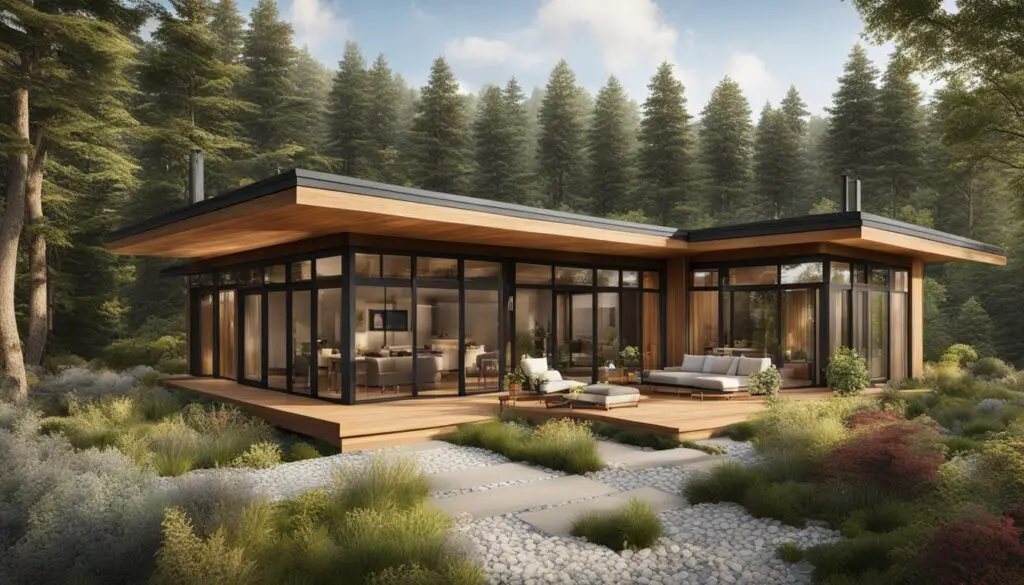
Comparing Materials for Biophilic Design
| Material | Sustainability | Aesthetic Appeal |
|---|---|---|
| Reclaimed Wood | High | Warm and rustic |
| Bamboo | High | Modern and eco-friendly |
| Low VOC Paints | High | Wide range of colors |
| Natural Stone | Medium | Elegant and timeless |
The Future of Biophilic Design in Home Remodeling
Biophilic design has become a powerful force in the world of home remodeling, and its influence is only expected to grow in the future. As more homeowners recognize the numerous benefits of incorporating natural elements into their living spaces, the demand for biophilic design will continue to rise.
Advancements in technology and materials will play a significant role in shaping the future of biophilic design. As designers and remodelers become more adept at seamlessly integrating nature into indoor spaces, innovative and sustainable design solutions will emerge.
Imagine a future where homes are intricately designed to inspire a deep connection with nature. From living walls adorned with lush greenery and cascading water features, to smart lighting systems that mimic natural sunlight, biophilic design will transform homes into tranquil havens that enhance our well-being.
For instance, imagine being able to control the temperature and humidity of your indoor garden through an automated system or experiencing the soothing sound of a simulated forest in your bedroom. These are just a glimpse of the possibilities that lie ahead.
The future of biophilic design also holds promise for sustainability. As our awareness of environmental issues grows, homeowners will increasingly prioritize the use of sustainable materials and energy-efficient systems in their remodeling projects. Biophilic design will provide the perfect avenue for creating homes that not only connect us to nature but also minimize our ecological footprint.
In conclusion, the future of biophilic design in home remodeling is one filled with endless possibilities. As technology continues to advance and our understanding of the importance of nature deepens, biophilic design will shape the way we live and transform our houses into harmonious oases of well-being.
Conclusion
Biophilic design has emerged as a transformative trend in home remodeling, offering homeowners the opportunity to create spaces that bring nature indoors. The innate connection between humans and nature is at the heart of biophilic design, which not only enhances the aesthetic appeal of living spaces but also promotes physical and mental well-being.
By incorporating biophilic design principles, homeowners can enjoy the benefits of a healthier and more sustainable living environment. Natural elements such as sunlight, greenery, and natural textures have been proven to reduce stress, improve cognitive function, and enhance overall well-being. Additionally, integrating natural materials and maximizing natural light can reduce energy consumption and contribute to a more sustainable way of living.
As the future of home remodeling trends, biophilic design is here to stay. Homeowners can take advantage of this trend to transform their homes into tranquil, nature-inspired havens. By creating spaces that evoke a sense of harmony and connection with nature, homeowners can enjoy the beauty and tranquility of the outdoors from the comfort of their own homes.
FAQ
What is biophilic design?
Biophilic design is an approach in interior design that recognizes the connection between humans and nature and aims to bring elements of nature into indoor spaces. It is a transformative trend in home remodeling projects, incorporating natural materials, plants, and natural light to create harmonious living environments.
What are the benefits of biophilic design in home remodeling?
Biophilic design offers numerous benefits to homeowners. It has been shown to reduce stress, improve cognitive function, enhance well-being, and promote better sleep. It also improves air quality, increases productivity, and creates a sense of tranquility and connection to nature within living spaces.
What are some key elements of biophilic design?
Key elements of biophilic design include the use of natural materials such as wood, stone, and bamboo, the integration of indoor plants and green walls, maximizing natural light through large windows and skylights, and incorporating water features such as fountains or aquariums. Using natural colors and patterns, incorporating views of nature, and creating spaces for relaxation and reflection are also important aspects of biophilic design.
How can biophilic design be applied to different rooms in the home?
Biophilic design principles can be applied to every room in the home. For example, in the living room, incorporating large windows with views of nature, using natural materials for furniture and decor, and adding indoor plants can create a calming and inviting atmosphere. In the kitchen, using natural materials for countertops and cabinets, adding a herb garden, and maximizing natural light can enhance the connection to nature. Similarly, in bedrooms, incorporating natural textures and colors, creating a view of outdoor greenery, and using circadian lighting can promote restful sleep and relaxation.
Is biophilic design sustainable?
Yes, biophilic design and sustainability go hand in hand. By bringing nature into our homes, we can reduce our reliance on artificial lighting and ventilation, leading to energy savings. Using sustainable materials in renovation projects, such as reclaimed wood or low VOC paints, also aligns with the principles of biophilic design. Additionally, incorporating energy-efficient appliances and systems can further enhance the sustainability of biophilic design projects.
What is the future of biophilic design in home remodeling?
Biophilic design is expected to continue shaping the future of home remodeling. As more homeowners recognize the benefits of living in harmony with nature, the demand for biophilic design elements and principles will only increase. Advancements in technology and materials will further facilitate the integration of nature into indoor spaces, allowing for more innovative and sustainable design solutions.



